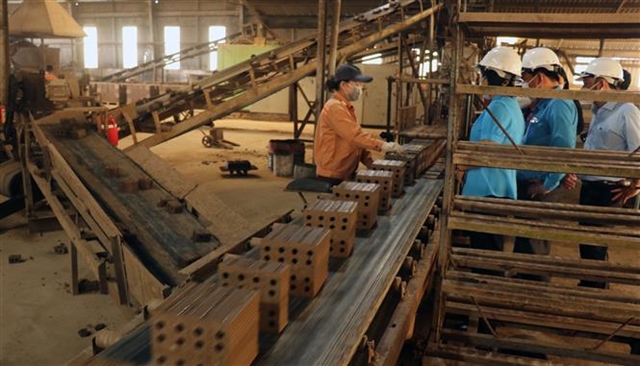Rising prices, domestic demand and evolving regulations have combined to lift the sector's performance and investor sentiment this year.

HÀ NỘI — The domestic construction material industry is showing strong signs of a resurgence this year, driven by a mix of favourable demand-side developments and strategic supply constraints.
With both real estate and public investment sectors picking up pace, the outlook for listed building material companies appears increasingly optimistic, supported by higher prices, improved profit margins and evolving market dynamics.
According to Vice Chairman of the Vietnam Association of Building Materials Phạm Văn Bắc, key construction materials such as sand and bricks have seen noticeable price increases since the start of 2025.
While cement prices have risen more moderately and stone remains relatively stable, the overall price trend supports stronger margins across the sector.
“The rise in prices will help companies gradually improve profitability,” said Bắc.
He attributes this to dual pressures: rising demand and constrained supply.
The real estate market is bouncing back following policy and financing reforms, while the Government is fast-tracking infrastructure projects under the public investment agenda.
At the same time, environmental regulations have tightened, especially around the exploitation of natural resources such as clay and sand.
A notable structural shift is occurring in the sand segment.
As natural sand becomes scarcer due to regulatory tightening, demand is tilting toward manufactured sand produced from crushed limestone, granite and basalt.
Previously considered a less-competitive option, artificial sand is now emerging as a strategic product, particularly for firms that have already invested in production capacity.
With favourable pricing and growing market acceptance, artificial sand is poised to play a larger role in future construction supply chains.
The steel sector recovers with caution
Steel consumption in Việt Nam is projected to increase by approximately 14 per cent in 2025, supported by higher activity in housing completions and infrastructure.
Anti-dumping measures implemented in the first quarter of the year have also limited the inflow of low-cost Chinese steel, providing some pricing relief to local producers.
Still, risks remain.
A surge in Chinese steel inventories poses a threat to pricing stability, and falling global iron ore prices may further compress margins.
According to KB Securities (KBSV), domestic steel prices are expected to remain relatively stable, sustained by internal demand, despite these external pressures.
Meanwhile, the plastic pipe segment, especially PVC-based products, is expected to benefit from solid demand growth in urban infrastructure and residential construction.
Technical standards and high transportation costs offer domestic producers a natural protection against imports.
However, raw material volatility, particularly in PVC prices, may continue to challenge cost control and profitability.
The cement industry faces a unique set of challenges. While demand is increasing, especially from infrastructure projects, total national supply is projected to reach 124.8 million tonnes in 2025, nearly double the expected domestic consumption of around 63 million tonnes.
In this context, companies are under pressure to manage costs, promote premium products and improve efficiency. Competition remains intense, especially among firms lacking vertical integration or raw material reserves.

Promising growth
Several firms are responding proactively.
High Grade Brick Tile Corporation plans to produce 25 million bricks and 120,000 cubic metres of clay in 2025.
With existing clay reserves, the firm has a key advantage under current licensing constraints. It targets VNĐ33.7 billion (US$1.3 million) in revenue and VNĐ3.7 billion in profit before tax, a notable jump over its 2024 performance.
Vicem Bút Sơn expects to sell 3.33 million tonnes of cement in 2025, with revenue of nearly VNĐ2.8 trillion and profit after tax of VNĐ29.3 billion, a reversal from a VNĐ201 billion loss last year.
The firm is emphasising specialised products like Bút Sơn Xanh to differentiate its offerings.
Similarly, Vicem Hà Tiên JSC targets 6.37 million tonnes in sales and revenue exceeding VNĐ7.1 trillion, with profit after tax projected at VNĐ184 billion, triple last year’s level.
A return on equity of 3.89 per cent reflects improved operational focus and market strategy.
Despite the favourable backdrop, analysts caution that high input costs could limit margin expansion.
While rising selling prices improve revenue potential, actual profit growth depends on cost discipline, noted Trương Hiền Phương, senior analyst at KIS Vietnam.
He emphasised the need for careful risk management, especially in sourcing and logistics.
KBSV recommends focusing on companies with integrated supply chains and pricing power, citing Hòa Phát Group, Hoa Sen Group, Nam Kim Group and Bình Minh Plastics as attractive picks due to their production scale, product diversity and export readiness. — BIZHUB/VNS





